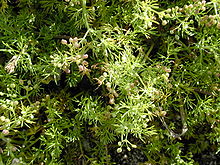
Celery is a marshland plant in the family Apiaceae that has been cultivated as a vegetable since ancient times. Celery has a long fibrous stalk tapering into leaves. Depending on location and cultivar, either its stalks, leaves or hypocotyl are eaten and used in cooking. Celery seed powder is used as a spice.
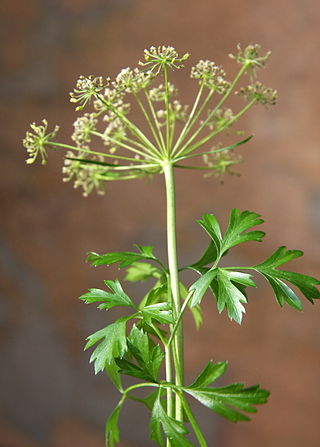
Parsley, or garden parsley is a species of flowering plant in the family Apiaceae that is native to Greece, Morocco and the former Yugoslavia. It has been introduced and naturalized in Europe and elsewhere in the world with suitable climates, and is widely cultivated as a herb, and a vegetable.

Asphodelus fistulosus is a species of plant known as hollow-stemmed asphodel, onionweed, onion-leafed asphodel, and pink asphodel. It is native to the Mediterranean region. It is an invasive exotic weed in the United States, with significant infestations in California, Arizona, New Mexico, and Texas. It is listed as a Federal Noxious Weed by the United States Department of Agriculture. It is also a common weed in parts of Australia, New Zealand, and Mexico, and it thrives in any area with a Mediterranean climate.
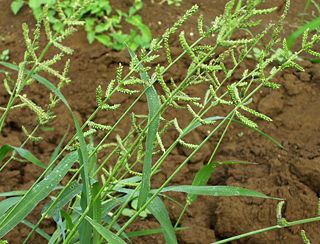
Echinochloa colonum, commonly known as jungle rice, wild rice, deccan grass, jharua or awnless barnyard grass, is a type of wild grass originating from tropical Asia. It was formerly classified as a species of Panicum. It is the wild ancestor of the cultivated cereal crop Echinochloa frumentacea, sawa millet. Some taxonomists treat the two taxa as one species, in which case the domesticated forms may also be referred to as E. colonum.

Apium is a genus of about 20 species of flowering plants in the family Apiaceae, with a subcosmopolitan distribution in Europe, Asia, Africa, South America and Australia. They are medium to tall biennials or perennials growing up to 1 m high in the wet soil of marshes and salt marshes, and have pinnate to bipinnate leaves and small white flowers in compound umbels. Some species are edible, notably Apium graveolens, which includes the commercially important vegetables celery, celeriac and Chinese celery. Apium bermejoi from the island of Menorca is one of the rarest plants in Europe, with fewer than 100 individuals left.
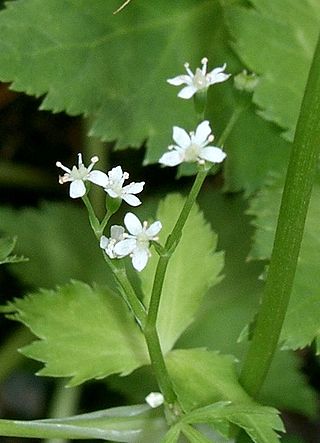
Cryptotaenia japonica, commonly called mitsuba, Japanese wild parsley and Japanese honewort among other names, is a herbaceous perennial plant in the celery family native to Japan, Korea and China. The plant is edible and is commonly used as a garnish and root vegetable in Japan, and other Asian countries. It is sometimes considred a subspecies of Cryptotaenia canadensis as Cryptotaenia canadensis subsp. japonica.

Soliva sessilis, one of up to nine species of the genus Soliva, is a low-growing herbaceous annual plant. Its common names include field burrweed, Onehunga-weed, lawn burrweed, lawnweed, jo-jo weed and common soliva. It is one of several plants also known as bindi weed, bindii, or bindi-eye.

Lilium canadense, commonly called the Canada lily, wild yellow-lily, or meadow lily, is a native of eastern North America. Its native range extends from Ontario to Nova Scotia south to Georgia and Alabama. It is most common in New England, the Appalachian Mountains, and the Canadian Maritimes. It is also cultivated as an ornamental in Europe and other places.

Ligusticum porteri, also known as oshá, wild parsnip, Porter’s Lovage or wild celery, is a perennial herb found in parts of the Rocky Mountains and northern New Mexico, especially in the southwestern United States.

Cyclospermum is a small genus of plants in the family Apiaceae. There are three species, including the well-known weed Cyclospermum leptophyllum, the marsh parsley or fir-leafed celery.

Citrus glauca, commonly known as the desert lime, is a thorny shrub or small tree native to Queensland, New South Wales, and South Australia. The 1889 book The Useful Native Plants of Australia records common names native kumquat and desert lemon.
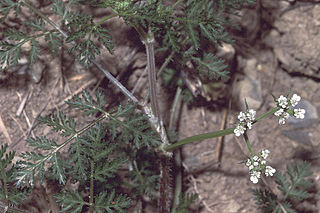
Caucalis platycarpos is a species of flowering plant in the family Apiaceae, the only member of the genus Caucalis. Common names are carrot bur parsley, small bur-parsley, and burr parsley. It is native to Europe, North Africa, and the Middle East as far east as Iran.

Chenopodiastrum murale, is a species of plant in the family Amaranthaceae known by the common names nettle-leaved goosefoot, Australian-spinach, salt-green, and sowbane. This plant is native to Europe and parts of Asia and northern Africa, but it is widespread worldwide, particularly in tropical and subtropical areas due to the ease of it being introduced. It is a common weed of fields and roadsides.
Apium virus Y (ApVY) is a plant pathogenic virus in the genus Potyvirus and the virus family Potyviridae.

Celery mosaic virus (CeMV) is a plant pathogenic virus in the genus Potyvirus and the virus family Potyviridae .
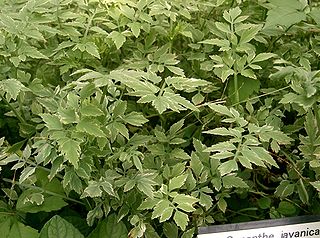
Oenanthe javanica, commonly Java waterdropwort, water celery, water dropwort, Chinese celery, Indian pennywort, minari and Japanese parsley, is a plant of the genus Oenanthe originating from East Asia. It has a widespread native distribution in temperate Asia and tropical Asia, and is also native to Queensland, Australia.

Torilis japonica, the erect hedgeparsley, upright hedge-parsley or Japanese hedge parsley, is a herbaceous flowering plant species in the celery family Apiaceae. Japanese hedge parsley is considered both an annual and biennial plant depending on the biogeographical location. This means Japanese hedge parsley can complete its life cycle in either one or two growing seasons depending on habitat. Japanese hedge parsley is typically found in areas with disturbed soils, pastures, margins, open woodland, near waste sites, or right-of-way habitats. It can withstand a variety of habitats, thriving in partial and full shaded areas, but also withstanding habitats with full sunlight penetration. It is considered an aggressive invasive species in North America; invading a wide range of habitats due to its environmental tolerance and tendency to outcompete native vegetation. This species is considered a threat in several areas that causes problems relating to overall environmental health and stability. Aside from its environmental implications, T. japonica has potential to fight several cancers through a terpene it produces called Torilin, extracted from its fruits.

Achyranthes aspera is a species of plant in the family Amaranthaceae. It is distributed throughout the tropical world. It can be found in many places growing as an introduced species and a common weed. It is an invasive species in some areas, including many Pacific Islands environments.

Cladium mariscus is a species of flowering plant in the sedge family known by the common names swamp sawgrass, great fen-sedge, saw-sedge or sawtooth sedge. Previously it was known as elk sedge. It is native of temperate Europe and Asia where it grows in base-rich boggy areas and lakesides. It can be up to 2.5 metres tall, and has leaves with hard serrated edges. In the past, it was an important material to build thatched roofs; harvesting it was an arduous task due to its sharp edges that can cause deep lacerations.

Ligusticum scoticum, known as Scots lovage, or Scottish licorice-root, is a perennial flowering plant in the celery family Apiaceae found near the coasts of northern Europe and north-eastern North America. It grows up to 60 centimetres (24 in) tall and is found in rock crevices and cliff-top grassland. It is closely related to, and possibly conspecific with, Ligusticum hultenii from the coast of the northern Pacific Ocean. The plant is edible and contains the compound sotolon, which is also present in fenugreek. The leaves have a flavour similar to parsley or celery, while the seeds taste similar to fenugreek or cumin.
